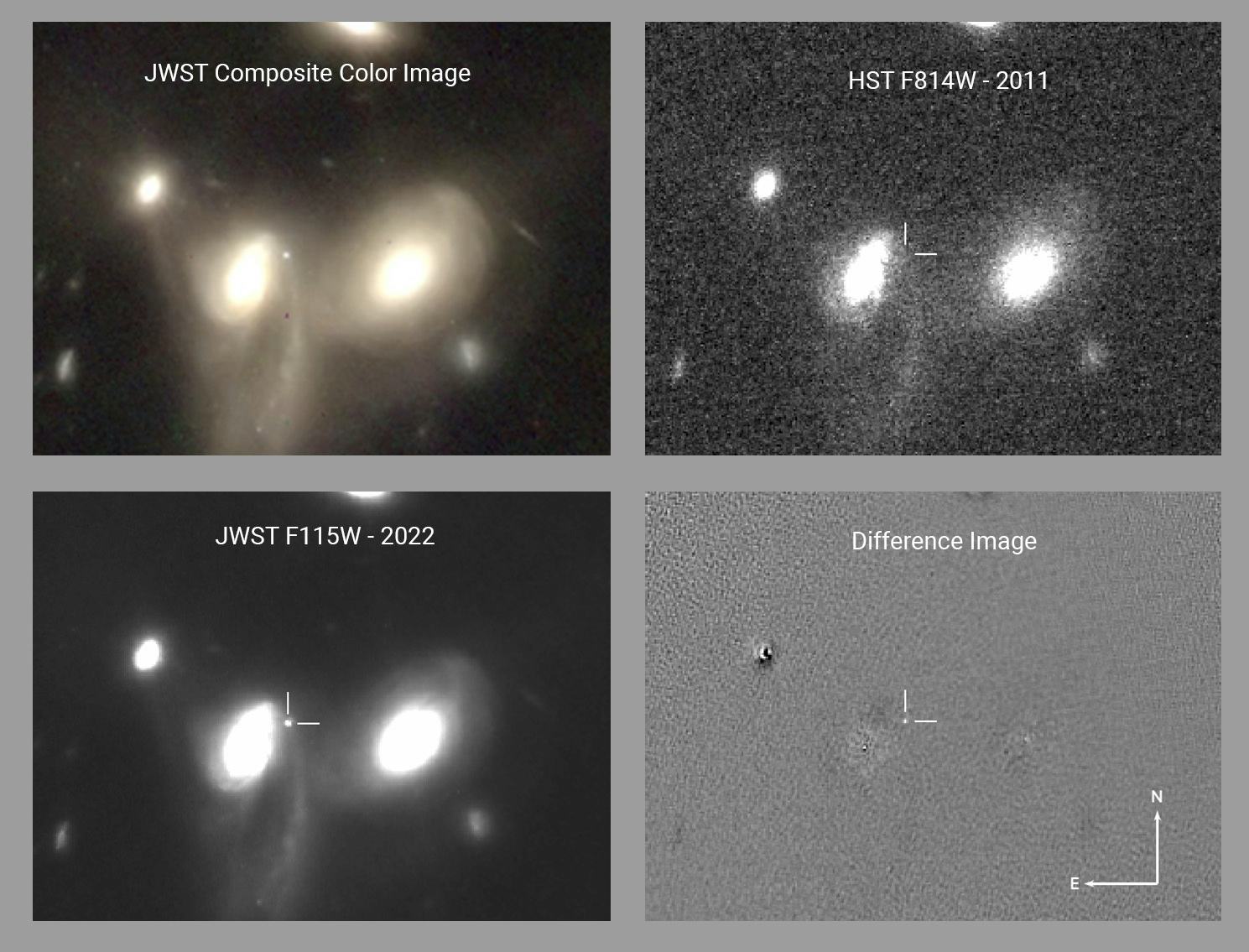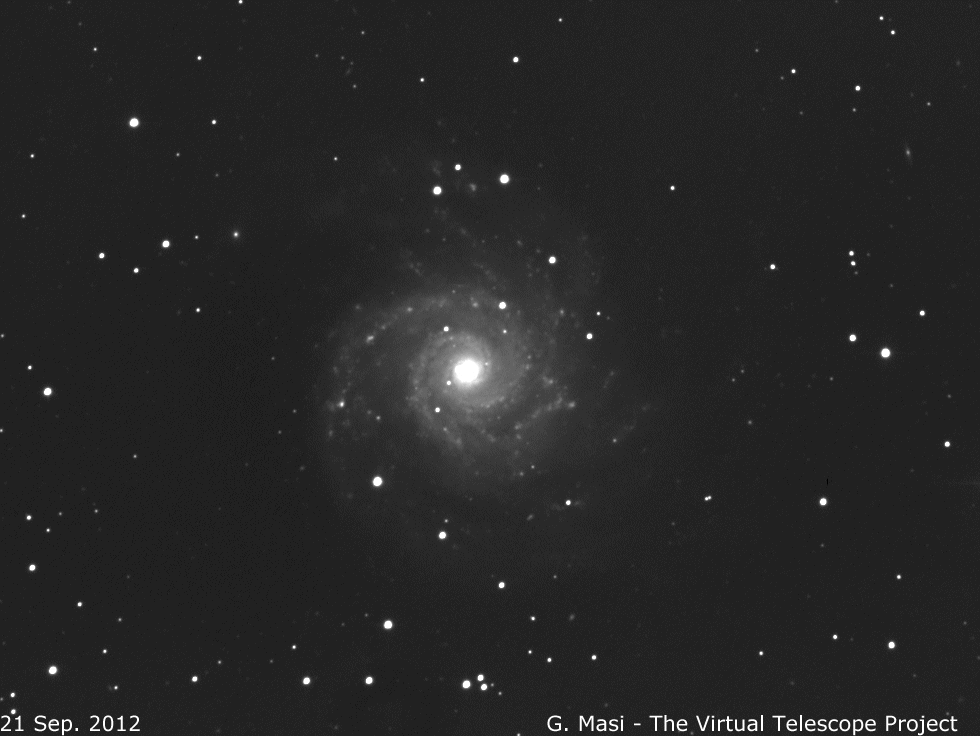
Astronomers spotted something unusual happening in a distant galaxy in recent images from the James Webb Space Telescope — something that wasn’t there when Hubble last looked at the same galaxy.
"We suspect it's a supernova," astronomer Mike Engesser of the Space Telescope Science Institute (STScI) tells Inverse. Finding short-lived cosmic events like supernovae isn’t what Webb was designed to do, but the newly-operational space telescope seems to be full of surprises. And this one could open the door for looking for the death throes of the universe's first generations of massive stars.
What’s New – Engesser and his colleagues say the bright object is probably the first supernova spotted by the Webb Telescope. It's extremely bright compared to the rest of the galaxy, for one thing. And Webb observed the galaxy, called SDSS.J141930.11+5251593, twice, five days apart; the object dimmed, just slightly, over those five days — classic supernova behavior.
"We would need more time series data to make a determination, but the data we do have does match that of a supernova, so it's a very good candidate," says Engesser.

The galaxy, whose unwieldy astronomical name we won’t repeat, is between 3 and 4 billion light years away, so astronomers are seeing the slowly fading light of an explosion that happened 3 to 4 billion years ago. The actual death of a star takes a fraction of a second, but the resulting fireball takes days to grow and brighten, then gradually fades away over the next few months. That's a blink of an eye in astronomical time, so it's sheer luck that Webb happened to spot this supernova shortly after its brightness peaked.
"Primarily, it's exciting because we have shown that we're able to find and detect new transients with Webb, which was something that JWST is not designed to do," says Engesser. "But it's one of the things we're showing we're able to do in sort of an ad hoc way."
Even as versatile it is, Webb isn't the kind of telescope astronomers typically use to hunt for short-lived objects like supernovae. Most of the time, that work is done by ground-based telescopes here on Earth, which image wide swaths of the sky every night.
Webb, on the other hand, looks much, much deeper into smaller patches of sky. The telescope's first deep-field image, released on July 12, covers an area of sky that you could cover with a grain of sand held at arm's length.
"So the actual likelihood that you'll find a transient in the field you're looking at is fairly small — or at least we thought it would be small," says Engesser. "But as you've probably heard, every JWST field is a deep field at this point, so there's galaxies everywhere, and now we're thinking, oh, we might have a really good chance of detecting supernovae all the time."
Here’s the background — The Earth-based telescopes that usually look for supernovae take images of the same wide areas of the sky every few nights. Their data-processing software compares every new image to previous images of the same area, looking for anything that might have changed.
To do the same thing with space telescopes, Engesser and his colleague compared new data from Webb's NIRCam instrument to Hubble images of the same area. They used software to look for any differences that might reveal what astronomers call "transients," objects that appear, vanish, brighten, or dim on a timescale we can actually see in real-time.
That's how the team found the supernova. It's also how they located a supernova that flared to life in 2013. Astronomers knew about that one, called 2013 EJ, but its once-bright fireball has long since faded too much for most telescopes to see it.
"There's a lot of questions about this particular object and what type of star it was, and its environment — like how dusty is it? It seems like it's very dusty," says Engesser.
Because supernovae tend to fade over a few months, astronomers don't usually get to see their much later stages, would could offer more clues about what type of star exploded, along with the physics of that stellar explosion. Webb's deep view of the universe could make the aftermath of a supernova like 2013 EJ easier to track even several years later.

"So observing this now with Webb is actually really cool as a way to investigate the super late environment around big, bright supernovae like this," says Engesser. "We're getting new insights that we have not been able to get before."
Engesser calls both detections — the newly-discovered supernova and the fading one scientists had lost sight of — a proof of concept. He and his colleagues are part of the Transient Science @ Space Telescope research team, led by astrophysicist Ori Fox at STScI. Fox's team wants to use Webb to look for supernovae in the oldest, most distant galaxies in the universe, the kind that even Hubble has trouble seeing.
"If we can detect new things, then that lets us do these sort of very fast-turnaround target of opportunity proposals, where we detect something and then we can say, 'Okay, interrupt everything else. We want to observe this thing right now; this is time-sensitive,'" explains Engesser. "Once we have a nice repertoire [of supernovae] built up, we can say, 'Okay, it's actually very worthwhile for us to have these time-sensitive observations of super high-redshift supernovae."
Why It Matters — Old, distant supernovae could help astronomers better understand the very fabric of the universe and how it's stretching and expanding over time. Most physicists now agree that the universe is expanding, and that that expansion is speeding up; that's thanks to a 1998 study that used a specific type of supernova to help measure distances between objects in the cosmos. These supernovae, called Type Ia supernovae, happen when a white dwarf star in a binary star system steals (or accretes) so much material from its companion star that the greedy white dwarf collapses under its own mass.
Because Type Ia supernovae are always the same brightness, astronomers can measure how bright a supernova appears in order to calculate how far away it, and its host galaxy, are. Astronomers call objects with known brightness "standard candles."
"By looking at the redshift of these supernovae, you can measure how fast they're moving away from you, as well as how far away they are," explains Engesser. "So one of the things we want to be able to do with Webb is to detect super-high-redshift supernovae to even more constrain the cosmological nature of the universe and how it's changing over time."
The oldest supernovae in the universe also contain clues about the short lives and violent deaths of the universe's first generation of very massive stars. Those ancient giant stars may have been very different from the giant stars in the nearby, recent universe that's more familiar to us.
"We think that stars in the first few million years would have been primarily, almost entirely, hydrogen and helium, as opposed to the types of stars we have now. They would have been massive – 200 to 300 times the mass of our Sun, and they would have definitely lived a sort of 'live fast, die young' lifestyle," says Engesser. "Seeing these types of explosions is something we haven't really done yet."
What’s Next – Engesser and his team haven't yet decided whether to take a second look at the supernova they discovered.
"Supernovae in the grand scheme of things are actually fairly common," he says. "This supernova is interesting insofar as Webb was the first one to find it, which is amazing. In itself, it might not be all that interesting. We're still looking into whether or not we want to do any followup observations of this thing."
If the astronomers do decide to study their newly-discovered supernova further, it could answer a few specific questions. Watching how the light from the supernova dims over time could reveal what type of supernova – such as Type Ia – Engesser and his colleagues found. Measuring the spectra of light from the supernova could reveal what chemical elements made up the parent star, and thus what type of star exploded so violently.
But in the meantime, Engesser and his colleagues are focused on finding more transient bright spots in Webb's deep views of the universe.
This story was updated on July 28, 2022 to include the final five paragraphs.







